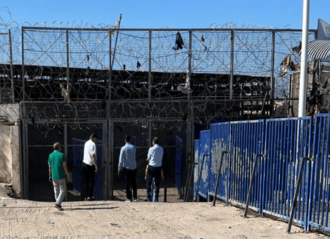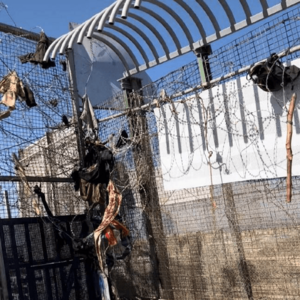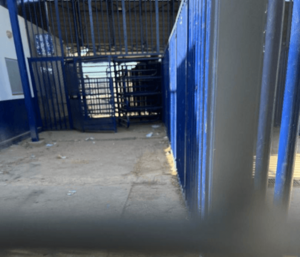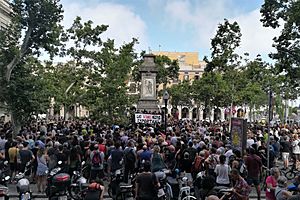2022 Melilla incident facts for kids
Quick facts for kids 
The gates of the buffer zone the day after the incident
|
|
| Date | 24 June 2022 |
|---|---|
| Location | Barrio Chino border crossing between Morocco and Spain |
| Deaths | 23 migrants |
| Non-fatal injuries |
|
| Missing | 70 migrants |
On 24 June 2022, 23 migrants were killed after a human stampede at the Melilla border fence during a conflict with Moroccan and Spanish security forces. Conflict broke out as between around 2,000 migrants gathered in the early hours of the day to cross the border with Spain.
Incident
The "incident" happened when close to 2,000 migrants, mostly from Sudan, moved on foot from the Aznouden forest near Nador towards Melilla. Security forces from both nations arrived to disperse the crowd but resulted in violent fighting with the migrants lasting for two hours. Spanish and Moroccan officials said that their border guards had been assaulted with weapons by migrants and had to fight back in self-defense.
Some migrants forced open a gate after reaching the border crossing, while others try climbing the border fence. After climbing the fence, many migrants got stuck in courtyards and hermetically closed turnstiles. The areas quickly got overcrowded, causing migrants to trample over each other, causing a stampede. Several other migrants fell from the fence onto the ground.
23 migrants were killed, 5 of whom died during the crossing attempt and 13 who died from their injuries in the hospital. 77 other migrants sustained injuries and 140 Moroccan officers were wounded, five seriously, and 49 Spanish Civil Guards were lightly injured. 133 people reached Spanish territory. 470 migrants were pushed back the border.
Prime Minister of Spain Pedro Sánchez said that the incident was a "well-organized, violent assault" by organized crime groups and thanked Spanish and Moroccan security forces for their actions.
Sidi Salem cemetery operators prepared several graves where Moroccan authorities buried the deceased.
Among the migrants held in custody in Nador, the Moroccan public prosecutor's office charged 29 migrants with felonies, including "organizing and facilitating the clandestine entry and exit of people to and from Morocco on a regular basis", "kidnapping and retention of a civil servant to use them as a hostage", "setting a fire in a forest", and "insults and violence against law enforcement agents". 36 migrants were charged with misdemeanors. Four of the 65 detainees are Chadian, while the rest are Sudanese. The Public Prosecutor's office ordered autopsies and identification of the deceased through DNA.
Aftermath
In September 2022, the General Directorate of Cadastre (DGC) and the National Geographic Institute (IGN), the two State institutions responsible for the delimitation of the territory in Spain, determined that the Melilla incident was perpetrated entirely on Spanish soil. Despite the fact that the incident occurred beyond the Melilla fence, the territory forms part of the "security zone" (not "no man's land"), which officially forms an integral part of Spanish territory, despite the fact that de facto, the Moroccan authorities are the ones that control the area even without having their sovereignty. That the Cadastre and the National Geographic Institute recognize as part of the national territory the place where all or a large part of the sub-Saharans died could have legal consequences since it would give the Spanish justice powers to investigate what happened. However, spokesmen for the Ministry of the Interior declared that "no one, neither the State security forces nor the Moroccan authorities, nor the Prosecutor's Office nor the Ombudsman, has the slightest doubt that the deceased were in Moroccan territory" and that "It is clear that the deaths occurred in the area of action of the Moroccan authorities, in which the civil guards did not have access."
Morocco’s National Human Rights Institution established a fact-finding commission on 27 June, the commission released a preliminary report on 13 July. The Spanish Ombudsman released their preliminary findings in October. The Moroccan Association for Human Rights accused the Moroccan authorities of trying to cover up the deaths, noting that six days after the tragedy, no autopsy had been performed and no effort had been made to identify the deceased. The Moroccan courts subsequently sentenced thirteen of the immigrants who failed to reach Spanish territory to two and a half years in prison and a fine of 10,000 dirhams.
Subsequently, El País carried out an investigation, analyzing the videos and with various interviews, in which it was stated that the death of at least one immigrant had occurred on the Spanish side. It also confirmed that they received tear gas and beatings by the police of both countries. Also, according to relatives, they counted 70 missing.
On December 23, 2022, the Spanish Prosecutor's Office decided to close the investigation into the deaths of emigrants in June at the Melilla border, exonerating the Ministry of the Interior, the Civil Guard and the agents who were on the border that day from any responsibility. land. According to elDiario.es, "the decree of the Public Ministry does not specify whether any of the deaths took place in Spanish territory, it states that" the events that led to the avalanche occurred in Moroccan territory" and that "the crowding of people occurred between both sites border”. The Prosecutor's Office understands that the actions of the guards were proportionate and informs the Civil Guard that several agents threw stones at the migrants, in case there was any type of disciplinary infraction.
See also
 In Spanish: Tragedia de la valla de Melilla para niños
In Spanish: Tragedia de la valla de Melilla para niños
- 2021 Morocco–Spain border incident




